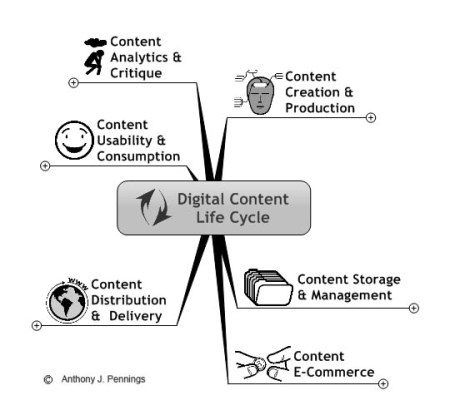Digital Content Flow and Life Cycle: The Value Chain
Posted on | July 14, 2017 | No Comments
In this post, I connect the idea of the digital content life-cycle to the concept of a value chain. E-commerce and other digital media firms can use this process to compare and identify value-creating steps and prioritize them within the organization’s workflow. They also become important in anticipating and analyzing needed human competences and digital skill sets.
The graphic below represents the key steps in the digital media production cycle, starting at one o’clock.
Long recognized by economists as part of the commodity production process where raw materials are processed into a final product via a series of value-adding activities, the value chain concept was refined by Michael Porter in 1985.
The idea of the value chain is based on the view of organizational outcomes as a series of transformative steps. He focused on the processes of organizations, seeing productive activities as a series of sequential steps. Central to this idea is seeing a manufacturing (or service) organization as a system, made up of subsystems each with inputs, transformation processes, and outputs.
Porter distinguished “primary activities” in the value chain from “secondary activities” in the sense that the former were more directly related to a final output. Primary activities include inbound logistics, production/operations, outbound logistics, marketing and sales, and services.[1] Raw materials come into the company through logistical processes and pass through production facilities that are coordinated via operations. These resources are transformed into a final product that is marketed to customers.
Activities such as procurement, human resource management, technological development, and infrastructure are secondary only in the sense that they provide support functions to the primary value chain. Departments such as accounting, finance, general management, government relations, legal, planning, public affairs, and quality assurance are necessary, but not primary. Porter didn’t diminish these activities but rather placed them in relation to output goals.
Both primary and secondary activities can help identify value-creating steps, supporting activities and prioritize them within the organization’s workflow.
An analysis of the flow of digital content production can help companies determine the steps of web content globalization.
In the early days of the Internet, Rayport and Sviokla (1995) presented the idea of a virtual value chain in the Harvard Business Review. They listed five activities involving the “virtual world of information” that help generate competitive advantage. In their article they suggest that gathering, organizing, selecting, synthesizing, and distributing information help companies use content and value-added resources to build new products and services and enhance customer relationships.[2]
They even suggested that newspapers could use the five value-adding steps to construct new products with the digital photography and other information resources they have available. Remember this was a time when the jpeg image was fairly new and companies like Real Networks were competing to become a video standard. No Facebook existed.
A digital chain analysis involves diagramming then analyzing the various value-creating activities in the content production, storage, monetization, distribution, consumption, and evaluation process. Each step can be analyzed and evaluated in terms of its contribution to the final outputs.
Furthermore, it involves an analysis of “informating” process, the stream of data that is produced in the content life cycle process. Digital content passes through a series of value-adding steps that prepare it for global deployment via data distribution channels to HDTV, mobile devices, and websites. Each of these steps is meticulously recorded and made available for analysis.[3]
The digital value chain is presented linearly here, but most data activities that add value operate as cycles. New ideas are conceived, new content is added, questions are constantly being asked, new ways of monetizing content is also extremely important. Also, how are audiences consuming the content? This leads the process back to the initial conception of content with the consideration of audience/consumer analytics and feedback.
Through this analysis, the major value-creating steps of content production and marketing process can be systematically identified and managed. In the graph above, core steps in digital production and linkages between them are identified in the context of advanced digital technologies. These are general representations but provide a framework to analyze the activities and flow of content production. Identifying these processes helps to understand the equipment, logistics, and skill sets involved in modern media production and also processes that lead to waste.
In other posts I will discuss each of the following:
Content Creation and Production
Content Storage and Management
Content E-Commerce
Content Distribution and Delivery
Content Usability and Consumption
Content Analytics and Critique
Notes
[1] Porter, Michael E. Competitive Advantage. 1985, Ch. 1, pp 11-15. The Free Press. New York.
[2] A version of this article appeared in the November–December 1995 issue of the Harvard Business Review.
[3] Singh, Nitish. Localization Strategies for Global E-Business.
© ALL RIGHTS RESERVED
 Anthony J. Pennings, PhD is Professor and Associate Chair of the Department of Technology and Society, State University of New York, Korea. Before joining SUNY, he taught at Hannam University in South Korea and from 2002-2012 was on the faculty of New York University. Previously, he taught at St. Edwards University in Austin, Texas, Marist College in New York, and Victoria University in New Zealand. He has also spent time as a Fellow at the East-West Center in Honolulu, Hawaii.
Anthony J. Pennings, PhD is Professor and Associate Chair of the Department of Technology and Society, State University of New York, Korea. Before joining SUNY, he taught at Hannam University in South Korea and from 2002-2012 was on the faculty of New York University. Previously, he taught at St. Edwards University in Austin, Texas, Marist College in New York, and Victoria University in New Zealand. He has also spent time as a Fellow at the East-West Center in Honolulu, Hawaii.
Tags: digital content lifecycle > digital content production > Michael Porter > value chain


